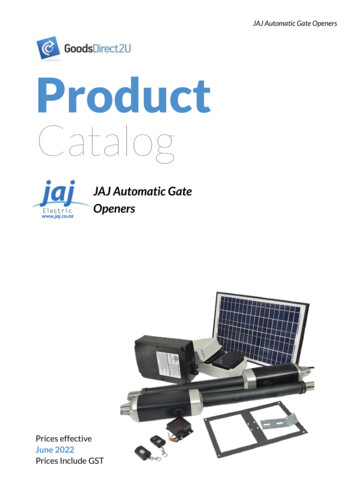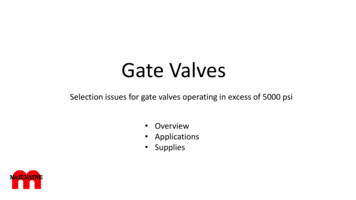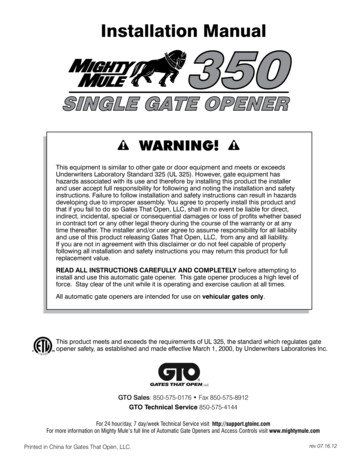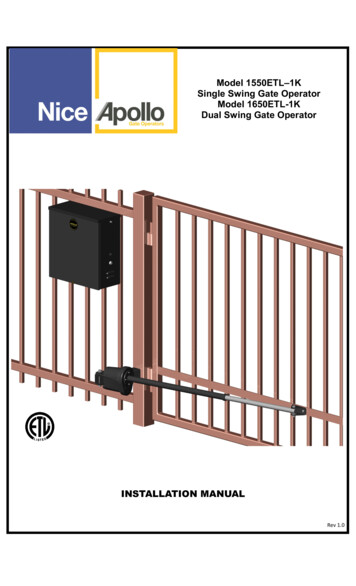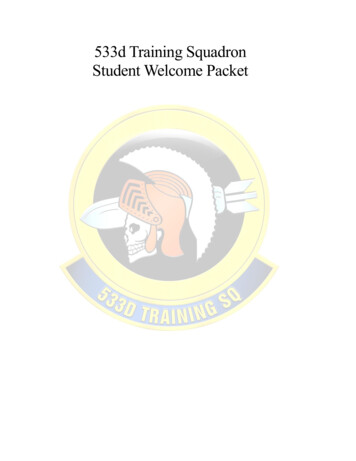
Transcription
The Stage-Gate Model: An OverviewBY SCOTT J. EDGETTGiven the large amount of resources – both people andmoney - dedicated to innovation in most companies, therate of return for success versus the cost of failure willhave a significant impact on whether your organizationwill achieve its revenue and profit goals from newproduct innovation. Hence the need for a businessprocess like Stage-Gate which drives value.Who are these companies with Stage-Gateinnovation processes that seem to win more in themarketplace than they lose? It is not hard to identifythem in any given industry. These are the companies thatyear-over-year have a proven innovation track record intheir industry sectors. Firms, for example, like 3M, AbbottNutrition, Baker Hughes, BASF, Corning, Exxon, GE,Hallmark, Kellogg, Pepsi, National Oilwell Varco, Procter& Gamble, to name but a few.More than 80 percent of companies in North Americause some type of a Stage-Gate innovation model.Worldwide the adoption of Stage-Gate continues togrow as organizations seek to improve their innovationcapabilities.Success. Do you have the ability to successfully developand launch new products and services into a competitivemarketplace on a sustainable basis?Companies that answer yes to this question have onething in common: They understand that productinnovation is a critical capability. They have successfully designed, implemented and internalized Idea-toLaunch innovation processes for conceptualizing,developing and commercializing new products andservices. More commonly, these processes are known asthe Stage-Gate model.1Stage-Gate : A Proven ApproachStage-Gate is a value-creating business process and riskmodel designed to quickly and profitably transform anorganization's best new ideas into winning newproducts.2 When embraced by organizations, it createsa culture of product innovation excellence - productleadership, high-performance teams, customer andmarket focus, robust solutions, accountability, alignment,discipline, speed and quality.Companies willing to work hard at creatinginnovation capabilities become top performers and arerealizing the benefits. Success rates, in the marketplace,are 2.5 times higher (63-78 percent) than the poorperformers that achieve only a 24 percent success rate. Stage-Gate InternationalProven Success DriversJust having an Idea-to-Launch process in place does notguarantee success. It must also have the traits that areproven to impact success. Does your process have thosetraits?Benchmark data has proven that successfulcompanies share some common features when it comesto innovation and their internal process capability. Five ofthese proven success ingredients of a good process are:1. Customer driven focus2. Upfront activities3. Tough Go/Kill decision points4. Truly cross-functional teams5. Top management involvementThese success traits should be built into anorganization’s DNA. Are they built into yours?1.Customer Driven FocusCustomer focussed innovation drives success rates thatare twice as high in the marketplace and have a muchhigher productivity rate (4.5 times). It is the number onekey to success and profitability. The goal is to maintain asharp focus on developing and delivering new productsthat are differentiated, solve major customer problemsand offer compelling value propositions to the customer.How: A customer driven focus is built into the entire Ideato-Launch process. Beginning right at the start with thefront-end of the process, ideas, both internally andexternally generated, are validated by voice-of-customeranalysis. A customer driven focus continues in eachsubsequent stage of the process by having constantwww.stage-gate.comStage-Gate and the Innovation Performance Framework are registered trademarks of Stage-Gate Inc. 1.905.637.8797Page 1
interactions with the customer, for example: conceptscreening and testing, early and rapid prototype testing toensure the design is staying true to what the customerwants and will pay for, gauging customer reaction andpurchase intent via working prototypes and customertrials.Key questions are asked and answered through-outeach stage of the process to ensure that the developmentteam understands what main benefits are important to thecustomer. This ensures that the new product/service will offernew and unique benefits that provide superior value to thecustomer and are better than the competition’s offering.2.Upfront ActivitiesSuccess or failure of a new product is often determinedbefore it even enters the development stage. It is thecritical upfront activities that define the attributes,features and benefits that will comprise a winning newproduct and provide an understanding of the customer’sperceived value.Companies with solid upfront activities built into theirinnovation process find this also reduces time to market. Itdoes so by sharpening the product and project definition;ensuring the product specs are correct; confirming productdesign early in the process and minimizing expensive lastminute changes and project scope creep. Top performingcompanies avoid rushing into product development thinkingthat they know best what the market wants. Instead, theytake the critical steps to ensure a well-defined productdefinition exists that has been validated with solid input frommarketing. Project scope creep and expensive, timedelaying, last minute changes that could have beenprevented with better information are minimized.How: Upfront activities are built right into the process withthe necessary time and resources allocated. A thoroughanalysis of the market, competition and customer isundertaken in advance of the development of the product.Activities such as concept screening and testing,feasibility assessments for technical, legal, financial andmanufacturing are also conducted to create a solidbusiness case to evaluate the project’s merits beforedevelopment work begins. Time is spent to understandwhat a winning new product must be. In many topperforming firms one outcome of building into the processa strong customer driven approach, supported by solidupfront activities, is the creation of a clear, fact-basedproduct definition. This then becomes a key output ordeliverable for this stage of work.3.Tough Go/Kill Decision PointsToo many projects, not enough resources; pipeline movingtoo slowly; projects that are never killed. These are allcommon symptoms that the innovation governancesystem is not working properly. Top performers ensurethat they have in place clear Go/No Go decision points (orGates) and clearly identified decision makers. Stage-Gate InternationalDecisions are made at their Gate meetings. Theyunderstand that effective Gate meetings are critical toenabling the entire process. In fact, having tough Go/NoGo decision meetings is one of the top drivers of asuccessful Stage-Gate process.How: Move towards having ‘Gates with Teeth’. Selectdecision points throughout your process wheremanagement and project teams can come together toreview a project and its merits for future funding. Eachproject is reviewed against clear decision criteria and theproject’s resource needs are compared against othercompeting projects in the pipeline. Fact based decisionsare made at these meetings. The decision makers are thepeople who own the resources and can make theallocation decisions required by the project teams tomove their project forward. Timely decisions are madeand projects are actually approved or killed.4.Truly Cross-Functional TeamsInnovation projects are complex and affect or requireinput from many different parts of an organization.Therefore, the way project teams are organized and howwell team members work together will impact both timeto-market and project success rates. Strong, talentedproject leaders who are accountable for a project’ssuccess leading truly cross-functional teams is a wellknown success driver. Unfortunately, many companiesfind they do not have enough of these types of skillswithin their innovation teams and organizations. Somecompanies still follow a functional silo resource allocationapproach to projects.How: Ensure your organization has clearly identifiedproject leaders with the skills to manage complexprojects under tight timelines. In today’s globaldevelopment environment teams need to have the crossfunctional skills and resources necessary to ensure thatthey can be successful. Remove roadblocks that mighthinder team members and, in turn, ensure project leadersand team members are accountable for the results.5.Top Management InvolvementIt all starts at the top. Top management must not only beclearly committed to product innovation, they also needto demonstrate strong and visible support. It cannot beunderstated. Without this visible support success rateswill decrease. Senior management must ‘walk the talk’.How: The leadership is responsible to set andcommunicate the innovation strategy and direction,allocate the necessary funding and provide guidance onthe balance between short term needs and long termgoals of the organization. Senior management must alsomaintain the right balance between oversight ofinnovation projects and empowering teams to get the jobdone. Executives need to set the pace and provide thesupport necessary for success.www.stage-gate.com 1.905.637.8797Page 2
Stage-Gate – An Idea-to-Launch Process3Can an organization dramatically improve the quality,speed, and profitability of their new product projectswhile driving down the risk of failure? Absolutely.The Stage-Gate idea-to-launch model is theindustry standard for managing new product innovationexcellence. The ground-breaking, widely implementedprocess expertly integrates numerous performancedriving best practices into an easy-to-understand recipefor success. Its robust design engages users of alldecision levels and functions, enabling quality execution,timely Go/Kill decisions, alignment and speed. The result:Superior products reaching markets faster and moreprofitably.Whether a company is developing gamechanging technologies and products that altercompetitive landscapes and create new markets, or it isintroducing new-to-company products to generate newrevenue streams, or whether it is defending market shareby releasing improved versions of products, the StageGate model improves performance and reduces your riskof failure.In addition to the benefits that are well-documented byresearch and benchmarking results many companiesthat have implemented and adopted an authentic StageGate process realize the following benefits:4 Accelerated speed-to-market Increased new product success rates Decreased new product failures Increased organizational discipline and focus on theright projects Fewer errors, waste and re-work within projects,less scope creep Improved alignment across business leaders Efficient and effective allocation of scarce resources Improved visibility of all projects in the pipeline Improvedcross-functionalengagementandcollaboration Improved communication and coordination withexternal stakeholders.How Does a Stage-Gate Process Work?The Stage-Gate process is based on the belief thatproduct innovation begins with ideas and ends once aproduct is successfully launched into the market. (SeeFigure 1)The Stage-Gate model breaks down the oftencomplex and chaotic process of taking an idea frominception to launch into smaller stages (where projectactivities are conducted) and gates (where businessevaluations and Go/Kill decisions are made). In itsentirety, Stage-Gate incorporates upfront predevelopment activities (customer driven businessjustification and preliminary feasibilities), developmentactivities (technical, marketing, and operations) andcommercialization activities (market launch and postlaunch learning) into one complete, robust businessprocess.Figure 1: A Typical Stage-Gate Process Stage-Gate Internationalwww.stage-gate.com 1.905.637.8797Page 3
The StagesA project leader drives the project through each stage. Eachstage is designed to collect specific information to help movethe project to the next stage or decision point. Each stage isdefined by the activities within it. These activities arecompleted in parallel (allowing for projects to quickly movetoward completion) and are cross-functional. The activitiesare designed to gather information and progressivelyreduce uncertainty and risk. Each stage is increasingly morecostly and emphasizes collection of additional informationto reduce uncertainty. The results of this integrated analysisbecome a set of deliverables that provide the input todecision meetings (Gates).In the typical Stage-Gate model, there are 5 stages,in addition to a robust front-end or Idea stage.Discover Pre-work designed to discover and uncover businessopportunities and generate new ideas.Stage 1 – Scope Quick, inexpensive preliminary investigation and scopingof the project. It is largely desk research.Stage 2 – Design Detailed investigation involving primary research(customer, market and technical) leading to a Business Casethat includes product and project definition, projectjustification, and the proposed plan for development.Stage 3 – Develop The actual detailed design and development of the newproduct and the design of the operations or productionprocess required for eventual full scale production.Stage 4 – Scale Up Tests or trials in the lab, plant and marketplace to verifyand validate the proposed new product, brand/marketingand production or operations plans.Stage 5 – Launch Commercialization: the beginning of full scale operations orproduction, marketing and sales.The GatesPreceding each stage, a project passes through a gatewhere a decision is made whether or not to continueinvesting in the project (a Go/Kill decision). These serve asquality-control checkpoints with three goals: ensure qualityof execution, evaluate business rationale, and approve theproject plan and resources.Each gate has a different purpose. For example,Gate 1 is a gentle, early screen of new ideas while Gate 3 isa tougher, business rational driven decision gate thatapproves projects to enter into the more expensivedevelopment stage. Each Gate is, however, structured in asimilar way:Deliverables: The project leader and team provide decisionmakers (Gatekeepers) with the high-level results of theactivities completed during the previous stage.Decision Criteria: Every project is measured against aclearly defined set of success criteria. The criteria should berobust to help identify winning products sooner. Theauthentic Stage-Gate process typically incorporates sixproven criteria: (See sample scorecard in Figure 2)Figure 2: Sample Gate 2 ScorecardSource: SG Navigator (www.stage-gate.com) Stage-Gate Internationalwww.stage-gate.com 1.905.637.8797Page 4
Strategic Fit Product and Competitive AdvantageMarket Attractiveness Technical FeasibilitySynergies/Core Competencies Financial Reward/Risk.Figure 3: The Innovation Performance Framework Outputs: A decision is made (Go/Kill/Hold/Recycle). If a Godecision is made, then new product development resourcesare committed to continue the project. The action plan forthe next stage is approved. A list of deliverables and a datefor the next gate meeting is set.The Stage-Gate model is designed to improve thespeed and quality of execution of product innovationactivities. The process helps project teams prepare the rightinformation, with the right level of detail, at the right gate tosupport the best decision possible. The process empowersthe project team by providing them with a roadmap withclear decisions, priorities, and deliverables at each gate.High quality deliverables submitted to Gatekeepers enablesbetter, more timely and fact-based decisions for allocatingcapital and operating resources.Modern Stage-Gate models also embrace andstrongly support the need to be: Fast and flexible – multiple processes exist to matchproject complexity and risk Customer driven - a customer centric approach is builtthroughout the entire process Dynamic and vibrant front-end – an ideation stage that isboth internally and externally focussed to generate thebest new ideas.Footnotes:1. Stage-Gate and Innovation Performance Framework areregistered trademarks of Stage-Gate Inc.2. Stage-Gate process was originally created by Stage-GateInternational’s co-founder Robert Cooper. For a comprehensiveoverview see Winning at New Products, 5th Edition3. This section is adapted from http://www.stage-gate.com/resourcesA Complete Innovation Performance Framework5The conceptualization and development of new productsand technologies is one of the more complicated initiativesan organization can undertake as new ideas migrate fromideation through the feasibility, development and scale-upstages and, finally, into commercialization. The Stage-Gateprocess is a time tested and proven way to guide anorganization though this. However, top performingcompanies also realize that this is only one piece, albeit acritical part of their internal innovation capability. TheStage-Gate process cannot be successful in isolationfrom other critical innovation capabilities. Instead topperformers have also taken steps to ensure that theirinnovation strategy, portfolio management and culture isaligned and integrated with their Stage-Gate process.(See Figure 3) Stage-Gate InternationalThese four, key internal pillars (Innovation PerformanceFramework) combined drive innovation value on asustainable basis. Top performing companies havemastered all four critical capabilities – have you?4. Additional benchmarking data and articles can be found onwww.stage-gate.com.5. Edgett, S.J. “Innovation: A Critical Capability”, The EuropeanBusiness Review, January-February, pp. 28-30, 2014About the AuthorScott J. Edgett, Ph.D. is Chief Executive Officer at Stage-GateInternational and is internationally recognized as one of theworld's top experts in product innovation. A co-author ofeight books and numerous articles, Dr. Edgett is a formerprofessor at the DeGroote School of Business at McMasterUniversity.For more information, visit: www.stage-gate.comEmail: scott.edgett@stage-gate.comwww.stage-gate.com 1.905.637.8797Page 5
proven to impact success. Does your process have those traits? Benchmark data has proven that successful companies share some common features when it comes to innovation and their internal process capability. Five of these proven success ingredients of a good process are: 1. Customer driven focus 2. Upfront activities 3. Tough Go/Kill decision .
